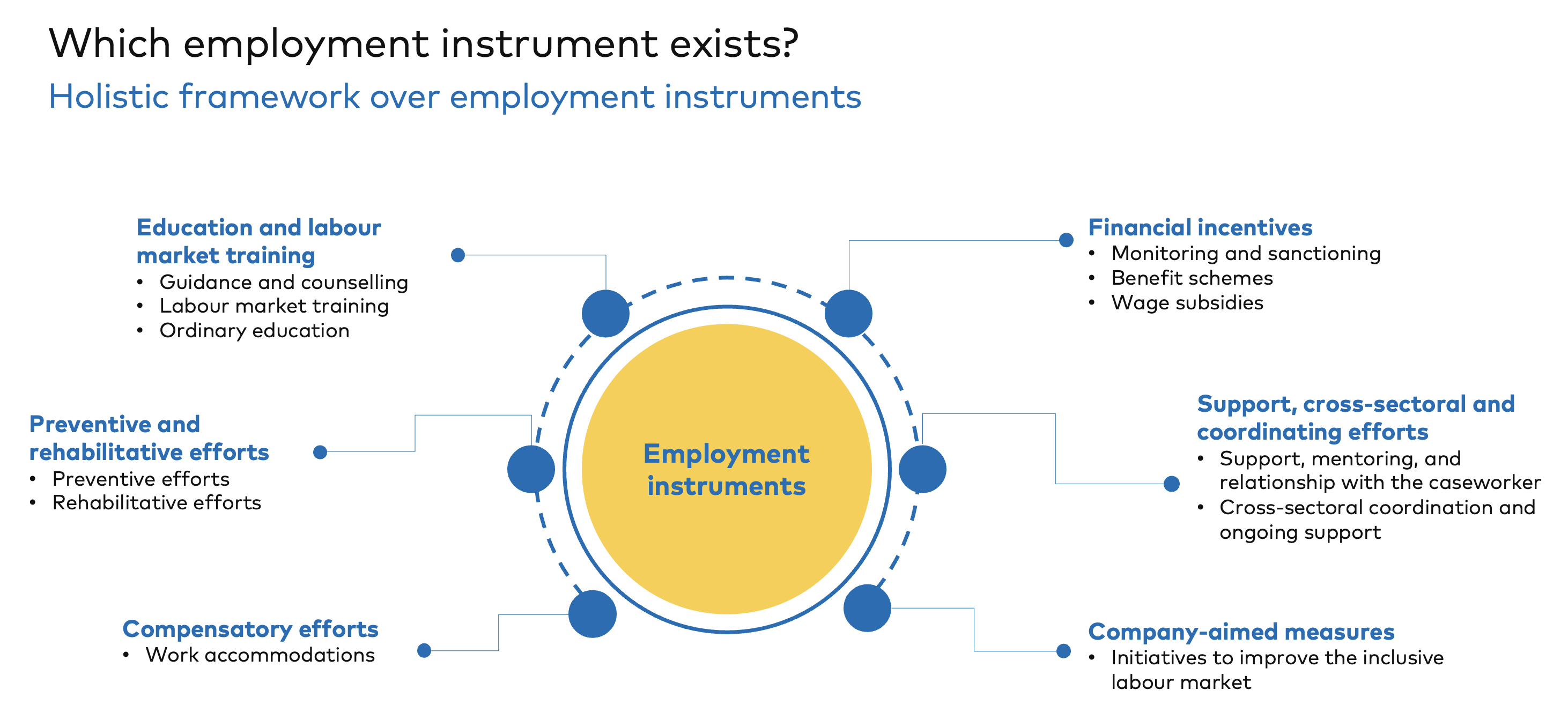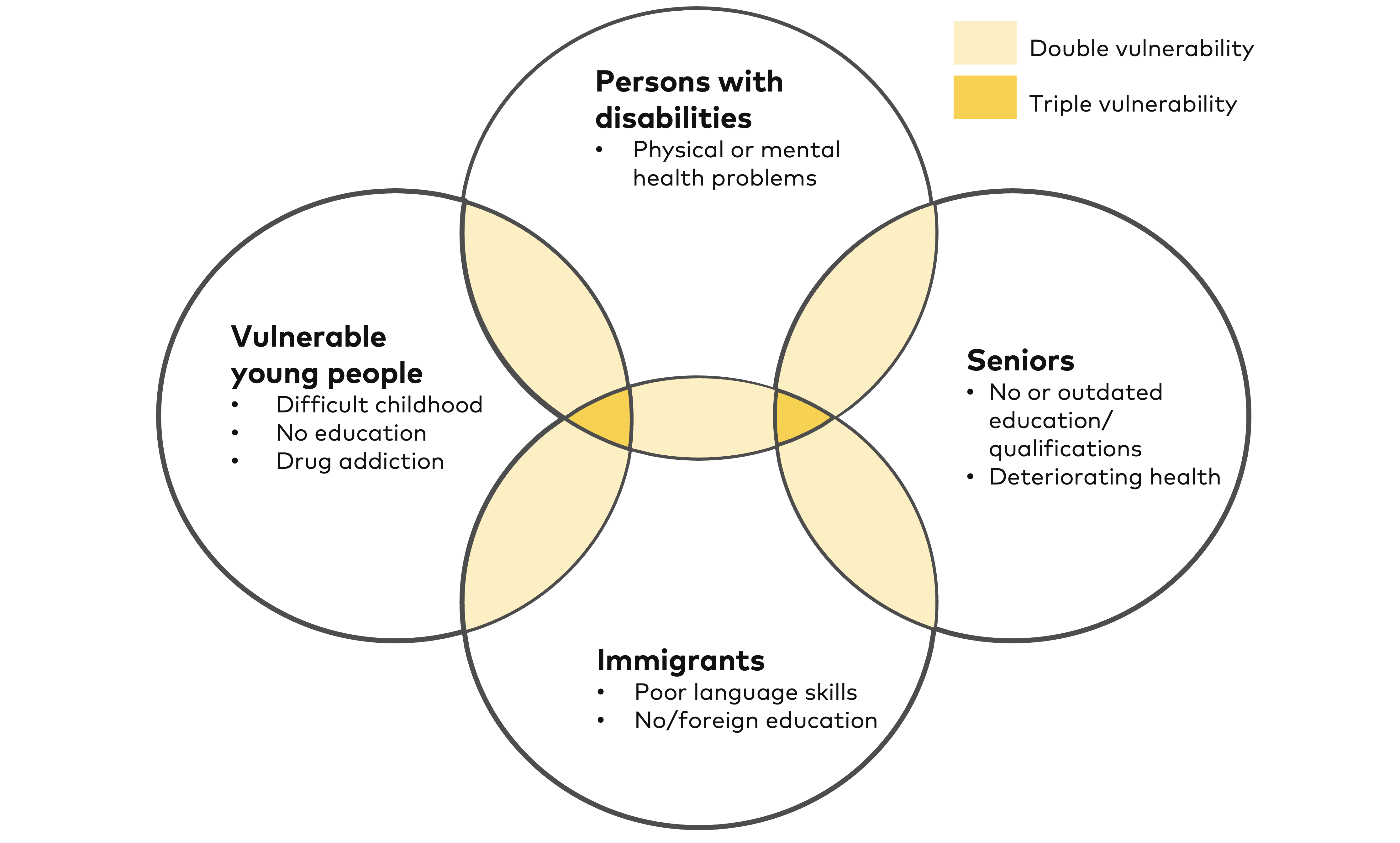2. Framework of employment instruments and target groups
In this chapter, we will present a framework of employment instruments, which we have developed to get a common and cohesive understanding of employment instruments in the Nordic countries. We define employment instruments as instruments targeted at helping individuals overcome employment barriers to increase their labour market participation. Moreover, we present a framework of the target groups which these instruments are designed to assist in finding a job. This framework is inspired both by previous reports in the project identifying the overlapping employment barriers confronting these individuals and by the interviews we have conducted with caseworkers across the Nordic countries. These interviews document the oft-entangled nature of the barriers confronting many persons on the margins of the Nordic labour markets.
2.1 Framework of employment instruments
We use the categorisation from Immervoll & Scarpetta (2012) as a starting point to narrow down ALMPs and employment support policies (AESPs). This categorisation separates the policies into: a) financial incentives, b) obligations of jobseekers, and c) programmes directed towards employment barriers on both the supply and the demand sides. The latter category can be divided into various programmes, such as labour market training, education, and job search assistance (Butchek & Walter, 2014; Card et al., 2018).
However, we have made some changes to this categorisation, since we want to stress that the toolbox available to help vulnerable groups into the labour market contains more than financial incentives and obligations, which should also be represented in the framework. This, for instance, includes cross-sectoral and coordinating efforts. Further, the changes to the framework were made to better suit the employment instruments used in the Nordic countries. The framework is presented in Figure 2.1 and consists of six different types of instruments. Each type of instrument is further disaggregated into subcategories.

Figure 2.1 Framework of employment instruments in the Nordic countries
The first category in the framework consists of education and labour market training, which involves classic active labour market instruments. It is divided into three subcategories, the first of which is guidance and counselling, referring to courses taking place at the employment services, such as CV and job search counselling. Second, it includes labour market training, which consists of various company internships where the individual is offered the opportunity to get work experience in actual workplaces. The third and last subcategory is ordinary education, which includes various types of educational activities taking place outside the employment services, e.g., upper secondary education and vocationally oriented education.
The second category in the framework comprises preventive and rehabilitative efforts, which are further divided into two subcategories addressing health challenges either before or after they occur. The first subcategory encompasses preventive efforts such as profiling. The second subcategory is rehabilitative efforts, which comprises various efforts that support individuals in re-entering the labour market after, for example, a health-related setback.
The third category in the framework consists of compensatory efforts. These are primarily targeted at individuals with health issues that hinder them from participating in the labour market. These compensatory efforts comprise various sorts of work accommodations, which may include reduced and flexible work schedules, modified work duties, assistance with transportation, the use of assistive devices, and personal assistance.
The fourth category in the framework comprises financial incentives, which is another central part in activation and employment support policies in the Nordic countries. The category consists of three subcategories. The first subcategory is monitoring and sanctioning individuals in their job search effort. The second subcategory is benefit schemes in the Nordic countries. Finally, we have included wage subsidies as a subcategory to financial incentives, since wage subsidies encourage employers by affecting their financial incentives to hire vulnerable individuals.
The fifth category within the framework consists of efforts that typically cross multiple authorities. This category is named support, cross-sectoral and coordinating efforts, and it consists of two subcategories. The first subcategory is support, mentoring, and relationship to the caseworker, which includes mentoring schemes and efforts to help vulnerable individuals deal with issues in their everyday life. Secondly, it consists of cross-sectoral coordination and ongoing support, and a central part of these instruments is coordination between several public authorities, including employment and health services, and ongoing support after an individual has found employment.
The sixth and final category in the framework is company-aimed measures, which consists of various initiatives to improve the inclusive labour market. It includes instruments such as campaigns and other measures to encourage companies to hire individuals outside the labour market (e.g., job carving). The latter refers to initiatives which reduce the administrative burden of companies when hiring vulnerable individuals and includes measures such as single entrance into the PES for companies when hiring vulnerable individuals.
The focus of the framework is primarily on the employment situation from the individual’s perspective. Therefore, it does not include efforts at the organisational level (such as how employment policies are implemented in the Nordic countries). Additionally, the framework is structural in nature; hence, it does not cover very short-term efforts to keep individuals employed during events such as a pandemic.
2.2 Framework over target groups
The focus of this report is on the efficient instruments that may help vulnerable individuals find work – perhaps a job requiring a low skill level in a short-term perspective or a path to a job requiring a more advanced skill level or tertiary education in a longer-term perspective. Many of the studies focus rather narrowly on one specific instrument, e.g., labour market training in a private or public workplace, which is tested using experimental or quasi-experimental methods that divide a target population into a treatment group and a control group. This is necessary to identify causal effects when validity of a study relies on the ability to keep everything equal, apart from the intervention status (treated/untreated). However, this situation is very far apart from the everyday experience of most caseworkers. These caseworkers typically interact with unemployed individuals with unique personal stories and very often also with a heterogeneous set of problems and employment barriers. In these situations, the caseworker has to find the right combination of tools to deal with these barriers within the limits of the law and with respect to available resources. In the interviews we have conducted across the Nordic countries, we have sought to deal with this situation by focusing, as our point of departure, on the main demographic target groups that were the starting point of this project, i.e., vulnerable youth, seniors, immigrants, and persons with disabilities, since we assumed that these groups are recognisable for the caseworkers that we wished to interview. We are fully aware that national employment legislation (alongside integration, health, and education legislation) typically defines target groups of policy interventions in other manners, with many differences, often very specific ones, between these groups and subgroups. However, in order to conduct a comparative study of how caseworkers in the employment services across the Nordics perceive the effectiveness of the instruments available to them, we had to abstract from these legislative differences in our interview approach (although references to legislation or resources often reappeared in the explanations the caseworkers gave us as to why they did what they did and used the instruments they used).

Figure 2.2 The complex work tasks of caseworkers: clients with intersecting vulnerabilities
As can be seen in Figure 2.2. – and as stressed above – the vulnerable groups and (some of) their barriers very often overlap. This does not necessarily imply that the groups themselves overlap. Persons belonging to the group of vulnerable youth (e.g., NEETs) and unemployed seniors as a group may both lack education, but these two groups do not overlap in a demographic sense, as you cannot be young and old at the same time. But you can be a member of the NEETs group and an immigrant at the same time or be an immigrant and a senior at the same time. Moreover, it is also possible to be either a young or an old immigrant and suffer from some form of physical or mental impairment. As our previous reports in the project show, and as the interviews later in this report also document, persons on the margins of the labour market often have to overcome several employment barriers. In Figure 2.2., some of these overlapping barriers are indicated in the intersections between the groups as double or triple vulnerabilities. Often, these double and triple vulnerabilities came up in the interviews with the caseworkers as they shared their knowledge and experience of which instruments and approaches appear to work with helping vulnerable individuals.